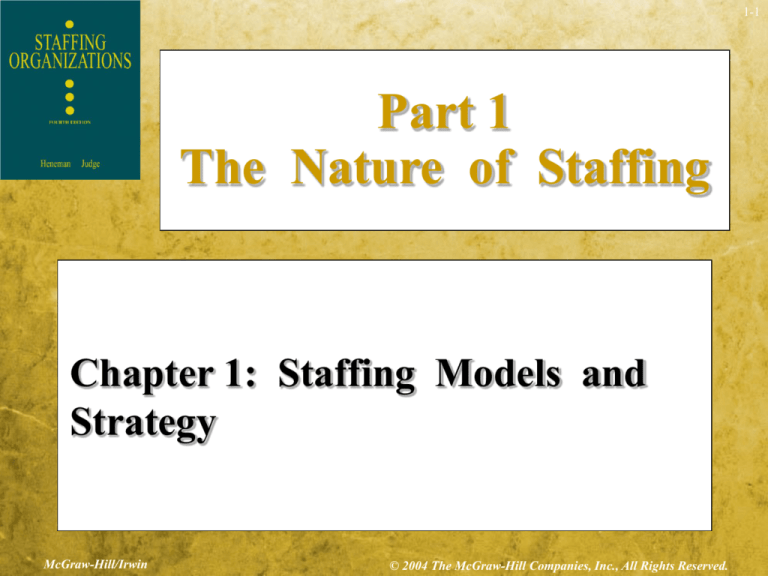
1-1
Part 1
The Nature of Staffing
Chapter 1: Staffing Models and
Strategy
McGraw-Hill/Irwin
© 2004 The McGraw-Hill Companies, Inc., All Rights Reserved.
1-2
CHAPTER ONE
Staffing Models and Strategy
Screen graphics created by:
Jana F. Kuzmicki, PhD
Troy State University-Florida and Western Region
McGraw-Hill/Irwin
© 2004 The McGraw-Hill Companies, Inc., All Rights Reserved.
1-3
Chapter Outline
Nature of Staffing
Staffing Models
Definition of Staffing
Staffing System Components
Implications of Definition
Importance to
Organizational Effectiveness
Staffing Organizations
Staffing Models
Staffing Quantity: Levels
Staffing Quality: Person/Job
Match
Staffing Strategy
Staffing Levels
Staffing Quality
Staffing System Examples
Plan for Book
Staffing Quality:
Person/Organization Match
McGraw-Hill/Irwin
© 2004 The McGraw-Hill Companies, Inc., All Rights Reserved.
1-4
Nature of Staffing
Definition
“Process
of acquiring, deploying, and retaining a
workforce of sufficient quantity and quality to create
positive impacts on the organization’s effectiveness”
Implications
Acquire,
Staffing
of definition
deploy, retain
as a process or system
Quantity
and quality issues
Organization
McGraw-Hill/Irwin
effectiveness
© 2004 The McGraw-Hill Companies, Inc., All Rights Reserved.
1-5
Nature of Staffing: Importance to
Organizational Effectiveness
Quotes from organization leaders
Survey results
Survey of executives regarding important issues indicated
“attracting, developing, and keeping good people” was among
the top five problems (mean = 6.18 on a 1-7 scale)
Organizations’ experiences
Acquisition of new leaders to lead a “reversal of fortunes”
Prevention of key leader losses
Use of talent as a source of competitive advantage
Impact of shortages of labor
Ability of managers to manage
Research findings
McGraw-Hill/Irwin
© 2004 The McGraw-Hill Companies, Inc., All Rights Reserved.
1-6
Staffing Models
Staffing
Quantity: Levels
Staffing
Quality: Person/Job Match
Staffing
Quality: Person/Organization Match
Staffing
System Components
Staffing
Organizations
McGraw-Hill/Irwin
© 2004 The McGraw-Hill Companies, Inc., All Rights Reserved.
1-7
Exh. 1.1: Staffing Quantity
Projected Staffing Requirements
Overstaffed
Compare
Fully Staffed
Understaffed
Projected Staffing Availabilities
McGraw-Hill/Irwin
© 2004 The McGraw-Hill Companies, Inc., All Rights Reserved.
1-8
Exh. 1.2: Person/Job Match
Job
Requirements
Rewards
Match
Person
HR Outcomes
Impact
Attraction
Performance
Retention
Attendance
Satisfaction
Other
KSAOs
Motivation
McGraw-Hill/Irwin
© 2004 The McGraw-Hill Companies, Inc., All Rights Reserved.
1-9
Concepts: Person/Job Match Model
Jobs are characterized by their
requirements and rewards
Individuals are characterized
via qualifications (KSAOS) and
motivation
Likely degree of fit between job
characteristics and person
Implied consequences for every
match
Examples - Clark and Jack
McGraw-Hill/Irwin
Concepts are not new
Matching process involves dual
match
KSAOs to requirements
Motivation to rewards
Job requirements expressed in
terms of both
Tasks involved
KSAOs necessary for
performance of tasks
Job requirements often extend
beyond task and KSAO
requirements
© 2004 The McGraw-Hill Companies, Inc., All Rights Reserved.
1-10
Exh. 1.3: Person/Organization Match
Organization
Values
New Job
Duties
Job
Requirements
Rewards
Multiple
Jobs
Match
Person
KSAOs
Motivation
McGraw-Hill/Irwin
HR Outcomes
Future
Jobs
Impact
Attraction
Performance
Retention
Attendance
Satisfaction
Other
© 2004 The McGraw-Hill Companies, Inc., All Rights Reserved.
1-11
Concepts: Person/Organization
Match Model
Organizational culture and values
Norms
of desirable attitudes and behaviors for
employees
New job duties
Tasks
that may be added to target job over time
“And other duties as assigned . . . “
Multiple jobs
Flexibility
concerns - Hiring people
who could perform multiple jobs
Future jobs
Long-term
McGraw-Hill/Irwin
matches during employment relationship
© 2004 The McGraw-Hill Companies, Inc., All Rights Reserved.
1-12
Exh. 1.4: Staffing System Components
Applicant
(Person)
Organization
(Job)
Recruitment
(identification and attraction)
Selection
(assessment and evaluation)
Employment
(decision making and final match)
McGraw-Hill/Irwin
© 2004 The McGraw-Hill Companies, Inc., All Rights Reserved.
1-13
Exh. 1.5: Staffing Organizations Model
Organization
Vision and Mission
Goals and Objectives
Organization Strategy
HR and Staffing Strategy
Staffing Policies and Programs
Support Activities
Core Staffing Activities
Legal compliance
Planning
Recruitment:
Selection:
External, internal
Measurement, external, internal
Job analysis
Employment:
Decision making, final match
Staffing System and Retention Management
McGraw-Hill/Irwin
© 2004 The McGraw-Hill Companies, Inc., All Rights Reserved.
1-14
Components of Staffing
Organizations Model
Organizational strategy
Mission and vision
Goals and objectives
HR strategy
Involves key decisions about size
and type of workforce to be
Acquired
Trained
Managed
Rewarded
Retained
May flow from organizational strategy and/or
May directly influence formulation of organization strategy
McGraw-Hill/Irwin
© 2004 The McGraw-Hill Companies, Inc., All Rights Reserved.
1-15
Components of Staffing
Organizations Model (continued)
Staffing strategy
An outgrowth of the interplay between organization and HR
strategy
Involves key decisions regarding acquisition, deployment,
and retention of organization’s workforce
Guide development of recruitment, selection, and
employment programs
Support activities
Core staffing activities
Serve as foundation for conduct of core staffing activities
Focus on recruitment, selection, and employment of
workforce
Staffing and retention system management
McGraw-Hill/Irwin
© 2004 The McGraw-Hill Companies, Inc., All Rights Reserved.
1-16
What is Staffing Strategy?
Definition
Requires
making key decisions about acquisition,
deployment, and retention of a company’s workforce
Involves
making 13 key decisions
Decisions
focus on two areas
Staffing
levels
Staffing
quality
McGraw-Hill/Irwin
© 2004 The McGraw-Hill Companies, Inc., All Rights Reserved.
1-17
Exh. 1.6: Strategic Staffing Decisions
Staffing Levels
Acquire or develop talent
Lag or lead system
Staffing Quality
Person/Job or
Person/Organization match
External or internal hiring
Specific or general KSAOs
Core or flexible workforce
Hire or retain
Exceptional or acceptable
workforce quality
National or global
Active or passive diversity
Attract or relocate
Overstaff or understaff
Hire or acquire
McGraw-Hill/Irwin
© 2004 The McGraw-Hill Companies, Inc., All Rights Reserved.
1-18
Examples: Staffing Systems
Police
department
Automobile
Theme
park
Telephone
McGraw-Hill/Irwin
plant
company
© 2004 The McGraw-Hill Companies, Inc., All Rights Reserved.
1-19
Plan of Book
Part
1: Nature of Staffing
Part
2: Support Activities
Part
3: Staffing Activities: Recruitment
Part
4: Staffing Activities: Selection
Part
5: Staffing Activities: Employment
Part
6: Staffing System and Retention
Management
McGraw-Hill/Irwin
© 2004 The McGraw-Hill Companies, Inc., All Rights Reserved.





